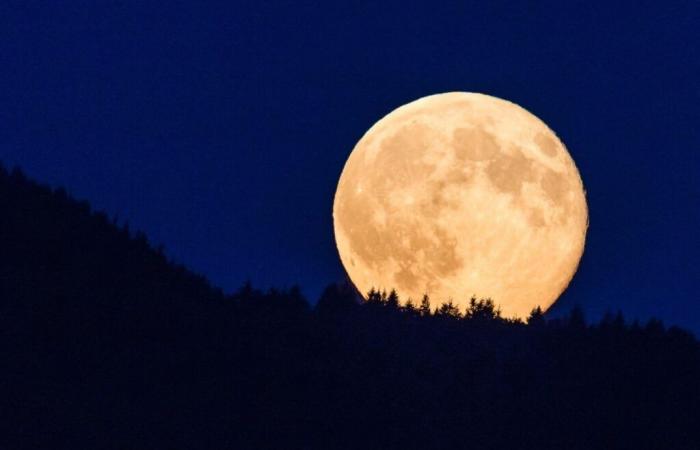– What makes the October Full Moon so special
Why does the star shine so intensely and appear so close to Earth? This Thursday, don’t miss the supermoon. Amazement guaranteed.
Published today at 7:03 a.m.
In our latitudes, in the southern sky, the Moon is at its highest level.
GETTY IMAGES
Subscribe now and enjoy the audio playback feature.
BotTalk
- The largest supermoon of the year will occur October 17-19.
- The supermoon occurs when the moon is at perigee, the point in its orbit closest to Earth.
- It appears 7% larger and 14% brighter than a typical Full Moon.
- The major lunar shutdown is a phenomenon that occurs every 18.6 years.
The Moon always has the same diameter. It is approximately 3475 kilometers. However, it sometimes seems bigger to us, sometimes smaller. The October Full Moon seems to be particularly prominent in the sky, as the September one already was. This is explained by two phenomena which currently influence the way we see it.
The first of these phenomena occurs on average every 13 months, but sometimes more, like this year. The Moon then becomes what we call a supermoon, a phenomenon linked to its orbit.
The Moon’s orbit around Earth is not round. It has the shape of an ellipse. This is why the Moon is sometimes closer, sometimes further away from us. When the distance is greatest, it is 406,740 kilometers from Earth. This phase is called the climax.
Thursday’s Super Moon, the interaction of the Full Moon and its perigee
But when it comes closest to Earth, at a distance of 356,410 kilometers, we speak of perigee. This happens every 27.55 days. This will be the case this Friday, October 18 at 3:23 p.m.
The Sun illuminates the Moon in a cycle of 29.53 days. This is the time it takes to go from one Full Moon to the next. The Full Moon occurs when the Sun and Moon are exactly opposite each other. We do not see it when it turns towards us its part in shadow and not its illuminated part.
If the Full Moon and perigee coincide more or less, the Full Moon then appears particularly close to us. It is called the Super Moon. The October Full Moon (Thursday October 17 at 1:26 p.m.) is, like its September predecessor, a supermoon. During this period, the Moon appears approximately 7% larger and 14% brighter than a typical Full Moon.
The Moon is very rarely further south than the Sun
Since July and until 2025, a second, rarer phenomenon will influence the position of the Moon in the sky. This phenomenon, called a major lunar shutdown, only occurs every 18.6 years. It will take place during the night from Friday to Saturday. The Moon will remain visible for a particularly long time and will rise very high in the sky.
The Moon then rises in places in the firmament where the sun is never found. And it appears to move more slowly across the sky, hence the term “stillness.”
Normally, the Moon follows paths similar to those of the Sun. It rises in the east and sets in the west. In our latitudes, it is always located in the south at its peak. But every 18.6 years, the Moon is higher (north) or lower (south) in the sky at its apogee than the sun can be.
The so-called lunar stop is due to the angle between the two orbits. The Moon’s orbit around the Earth deviates by an angle of about five degrees from Earth’s orbit around the sun.
In English, the October Full Moon is also called the “Hunter’s Moon.” According to NASA, this term was first mentioned in 1710 in the Oxford English Dictionary. Among the Native Americans, there were even more poetic designations. Thus, among the Algonquins of the northeastern United States, the October Full Moon was called “Traveler’s Moon”, “Blood Moon”, or even “Dying Grass Moon”.
“Latest news”
Want to stay on top of the news? “Tribune de Genève” offers you two meetings per day, directly in your email box. So you don’t miss anything that’s happening in your canton, in Switzerland or around the world.
Other newsletters
Log in
Alexandra Brohm is a science journalist. She studied at the University of Zurich and has worked for various newspapers for over 20 years. Since 2015, she has been an editor in the scientific section of the Tamedia editorial team in Zurich.More info
Did you find an error? Please report it to us.
16 comments







